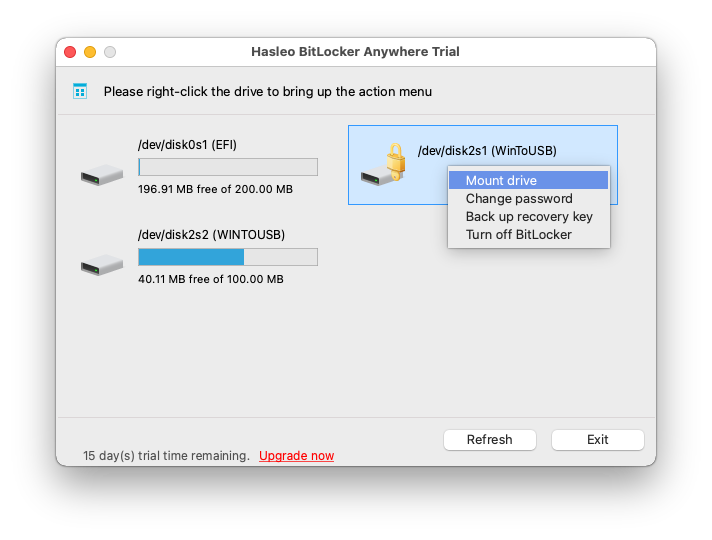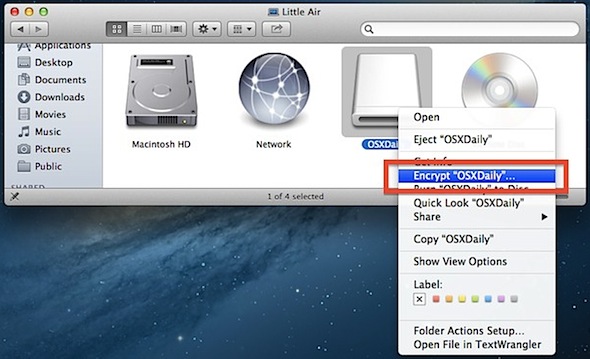Same Problem here on my Mac mini. All menus which allow me to encrypt external drives are missing. But macOS shows the menu item 'Decrypt' on all already encrypted drives and doesn't have problems mounting them. – DiableNoir Oct 8 '17 at 15:38. How to use an external hard drive on Mac AND PC + encrypt it? - posted in External Hardware: Hi all, thanks for any responses in advance. I have a 1 TB external hard drive that I need to be able.

Mac computers that have the Apple T2 Security Chip integrate security into both software and hardware to provide encrypted-storage capabilities. Data on the built-in, solid-state drive (SSD) is encrypted using a hardware-accelerated AES engine built into the T2 chip. This encryption is performed with 256-bit keys tied to a unique identifier within the T2 chip.
Jul 10, 2016 On my external drives, if a partition (or whole drive if smallish and used for TimeMachine) contains sensitive information, I use KeyChain to generate a long random passcode (25 characters, upper/lower, digits, special) and use it for encrypting. Just tried to encrypt a memory card on my Macbook Air. It says 'A GUID Partition Table (GPT) partioning scheme is required' What does this mean?
The advanced encryption technology integrated into the T2 chip provides line-speed encryption, but it also means that if the portion of the T2 chip containing your encryption keys becomes damaged, you might need to restore the content of your drive from a backup. This content includes system files, apps, accounts, preferences, music, photos, movies, and documents.
Always back up your content to a secure external drive or other secure backup location so that you can restore it, if necessary. You should also turn on FileVault for additional security, because without FileVault enabled, your encrypted SSDs automatically mount and decrypt when connected to your Mac.
Make a backup
Set up Time Machine or another backup method to regularly back up your Mac to a secure external source.
Files that you store in iCloud Drive, as well as photos and videos that you store in iCloud Photo Library, are automatically uploaded to iCloud. When you use iCloud Photo Library, full-resolution photos and videos are stored on your Mac by default and included in a Time Machine backup. If you choose to optimize iCloud Photo Library on your Mac, the full-resolution originals are not included in a Time Machine backup.
Turn on FileVault
Though the SSD in computers that have the Apple T2 Security Chip is encrypted, you should turn on FileVault so that your Mac requires a password to decrypt your data.
To turn on FileVault, follow these steps:
- Choose Apple menu () > System Preferences, then click Security & Privacy.
- Click the FileVault tab.
- Click , then enter an administrator name and password.
- Click Turn On FileVault.
Do you use an external drive or a flash drive to store some of your data? Then you might consider encrypting it. After all, it’s a bummer to lose a piece of equipment or have it stolen, but what’d take that from “bummer” to “nightmare” is knowing that someone may have access to, say, your private financial information. Ick. So let’s discuss how you can keep things secure under various recent versions of the Mac’s operating system.
Encrypting Disks Under 10.8 or 10.9
If you’re running Mountain Lion or Mavericks, this process is really, really easy. However, even though this first method theoretically shouldn’t erase any data on the drive, be sure you have a backup before you begin just in case things go all nutty on you. Better safe than…well, you know.
So to get started, right- or Control-click on the drive’s icon on your Desktop and pick “Encrypt [Name].”
If you don’t see that icon, you can either go to Finder> Preferences> General and turn on showing external disks on your Desktop…
Encrypt External Hard Drive Mac
…or you can right-click on the drive’s icon in Finder’s sidebar and encrypt it from there.
Whatever method you choose, the next step will be creating the drive’s password and coming up with a hint for it.
Of course, here comes the Big Bad Scary Caveat™—don’t forget this password, or you’ll lose access to the data on the drive. Irrevocably. Forever and ever. Bad bad bad. Write the password down on a sticky note and shove it in your underpants if you need to. Or store it in your password-management program, which would probably be safer and more sanitary.
Anyway, after you’ve typed in that info, click “Encrypt Disk,” and the process should begin. Unfortunately, there is no progress bar to tell you how far along you are, which is kind of a huge oversight on Apple’s part. You can right-click on the drive’s icon at any point to see if it’s still encrypting:
However, in my testing, that contextual menu sometimes shows spurious messages.
Um, what? You lie to me, menu.
So give it some time. This process can take hours depending on the size of the drive you’re encrypting, so go get some coffee or take a nap while you let it do its thing.
You can tell that it’s finished by right-clicking on that same icon. If you see “Decrypt [Name]” in black text, you’re ready to go!
Then whenever you plug in the disk afterward, it should ask you for the password.

For extra security, don’t select “Remember this password in my keychain,” and your Mac will ask you for the password every time.
Encryption with 10.7 Lion
So what do you do if you’re not running 10.8 or 10.9? The process isn’t much more difficult, but it does require that you erase the contents of the drive. What you’ll do is plug in the drive and open the Disk Utility program (it’s within Applications> Utilities).
Select the correct drive’s partition (it’s the named, indented icon) from the left-hand list.
Click on the Erase tab, and then from the “Format” drop-down menu, choose “Mac OS Extended (Journaled, Encrypted).”
Mac Encrypt External Disk
Name your soon-to-be-nuked drive whatever you like, and click “Erase” at the bottom-right. As before, you’ll have to then pick a password to get the process started.
I gotta repeat my warning: This will erase the data off of the drive you're encrypting. We’re clear on that, right?
Decrypt Mac Hard Drive
To be honest, I almost always use this method instead of the one I described above, even under Mavericks and Mountain Lion. It takes tons less time since it doesn’t have to preserve any existing files, and you actually get a Disk Utility progress bar to know when it’s finished. Of course, if you have to keep the stuff that’s already on the drive, the right-click method is your best choice.
Mac Hard Drive Encryption
One final point—if you encrypt a drive, don’t expect to be able to read its files on earlier versions of the operating system. A drive you encrypt under 10.9 won't be readable with a Mac running 10.6, for example. But no matter what, your data will be secure if it falls into the wrong hands. Don’t you feel better? I feel better. I like knowing that my extensive collection of Firefly fanfic is safe.